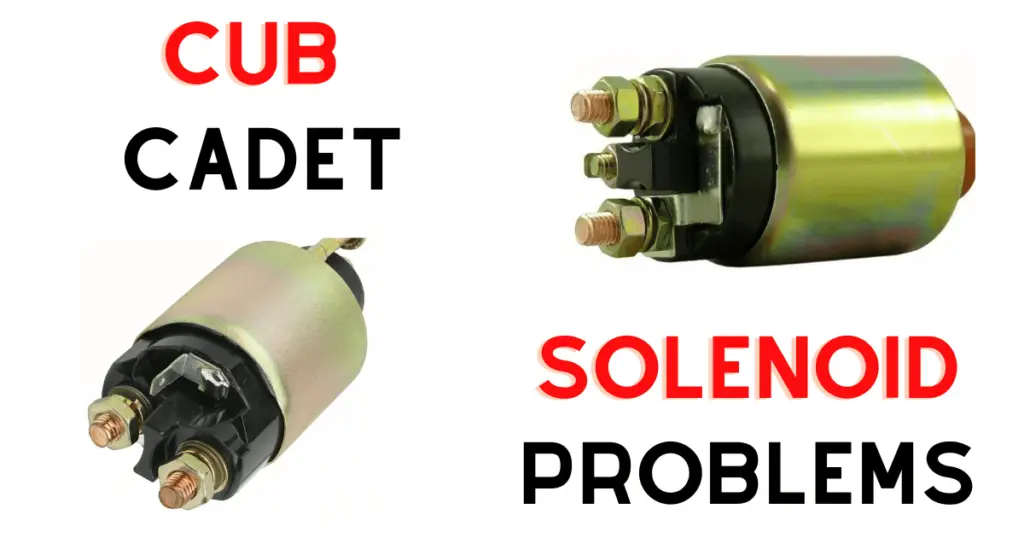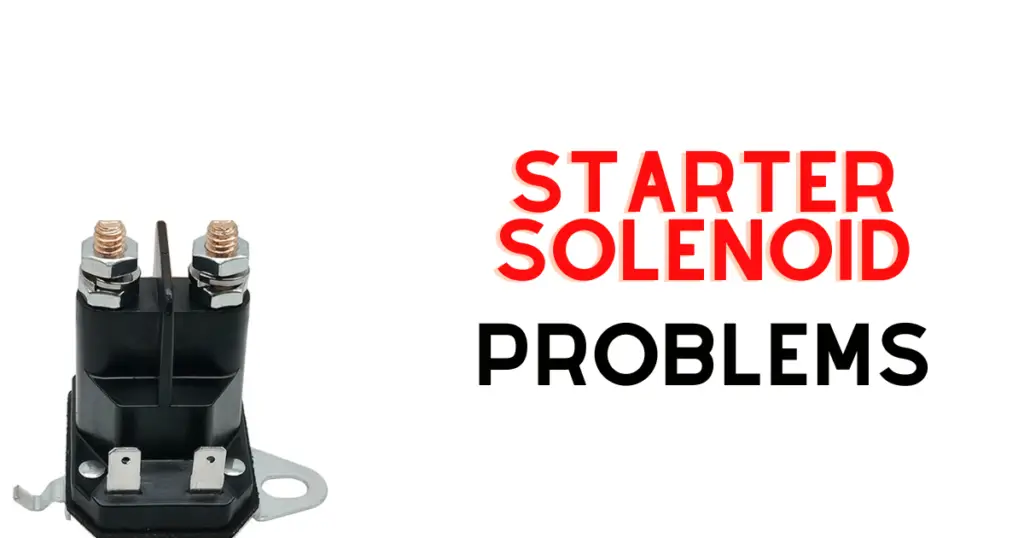Cub Cadet is a well-known brand that manufactures a wide range of outdoor equipment, including lawn mowers. However, like any other piece of machinery, Cub Cadet mowers can experience problems. One of the most common issues that Cub Cadet owners face is starter solenoid problems. The starter solenoid is a crucial component of the mower’s starting system, and when it fails, the mower won’t start.
Symptoms of a bad starter solenoid can vary, but some of the most common signs include a clicking sound when the key is turned, a rapid clattering sound, or the engine turning over but failing to start. If you’re experiencing any of these issues, it’s likely that your Cub Cadet’s starter solenoid is faulty. Fortunately, this is a relatively easy problem to fix, and most Cub Cadet owners can replace the starter solenoid themselves with a few basic tools.
In this article, we’ll explore the most common Cub Cadet starter solenoid problems and their solutions. We’ll also provide step-by-step instructions on how to diagnose and replace a bad starter solenoid. By the end of this article, you’ll have the knowledge and confidence you need to get your Cub Cadet mower up and running again.
Related issues:
– Cub Cadet Hydrostatic Transmission Problems (Complete Guide)
– Cub Cadet Steering Problems: Causes and Solutions
Understanding Starter Solenoid Functionality

Role of the Solenoid in Cub Cadet Mowers
The starter solenoid is an essential component in the ignition system of Cub Cadet mowers. It is an electromagnet switch that controls the flow of electric current from the battery to the starter motor. When the ignition switch is turned on, the solenoid receives an electrical signal from the battery and creates an electromagnetic force that pulls a copper plate towards the solenoid. This copper plate completes the circuit between the battery and the starter motor, which then turns the engine over.
Common Starter Solenoid Issues
Starter solenoids are prone to failure due to the high amount of current that passes through them. Some of the most common starter solenoid issues in Cub Cadet mowers include:
- Clicking sound when starting: If the starter solenoid clicks when the ignition switch is turned on, but the engine does not turn over, it could be due to a weak battery or a faulty solenoid.
- Starter motor not engaging: If the starter motor does not engage when the ignition switch is turned on, it could be due to a faulty solenoid or a problem with the starter motor itself.
- Starter motor runs continuously: If the starter motor runs continuously even after the engine has started, it could be due to a faulty solenoid or a Problem with the ignition switch.
In conclusion, the starter solenoid is a crucial component in the ignition system of Cub Cadet mowers. It is responsible for controlling the flow of electric current from the battery to the starter motor. Common starter solenoid issues include clicking sound when starting, starter motor not engaging, and starter motor running continuously. If you experience any of these issues, it is recommended to have your mower inspected by a qualified technician.
Diagnosing Starter Solenoid Problems

When a Cub Cadet mower fails to start, it could be due to a faulty starter solenoid. The starter solenoid is responsible for engaging the starter motor, which turns the engine over. If the starter solenoid is failing, it can cause a range of problems, including a clicking sound when attempting to start the engine or the engine not turning over at all.
Initial Symptoms of Failure
One of the initial symptoms of a failing starter solenoid is a clicking sound when attempting to start the engine. This clicking sound indicates that the starter solenoid is receiving power but is failing to engage the starter motor. Another symptom of a failing starter solenoid is when the engine fails to turn over when the key is turned. This symptom can be caused by a range of issues, including a weak battery, but a failing starter solenoid is a common culprit.
Using a Multimeter for Troubleshooting
To troubleshoot a failing starter solenoid, a multimeter can be used to test the voltage drop across the solenoid. First, ensure the battery is fully charged and the connections are clean and tight. Then, connect the multimeter to the battery and set it to measure DC voltage. Turn the key to the on position and measure the voltage. The voltage should be around 12 volts. Then, turn the key to the start position and measure the voltage again. If the voltage drops significantly, it indicates a problem with the starter solenoid.
It is also possible to test the resistance of the starter solenoid using a multimeter. Disconnect the battery and the starter motor from the solenoid. Then, set the multimeter to measure resistance and connect the probes to the solenoid terminals. The resistance should be between 4 and 6 ohms. If the resistance is outside of this range, it indicates a problem with the solenoid.
In conclusion, diagnosing starter solenoid problems on a Cub Cadet mower requires a methodical approach and the use of a multimeter. By being able to identify the initial symptoms of a failing solenoid and using a multimeter to test the voltage drop and resistance, it is possible to pinpoint the issue and take the necessary steps to fix it.
Electrical System Checks
When troubleshooting starter solenoid problems on a Cub Cadet mower, it is important to start with a thorough electrical system check. This will help identify any underlying issues that may be affecting the performance of the starter solenoid.
Battery Inspection
The first step in checking the electrical system is to inspect the battery. A bad or weak battery can prevent the starter solenoid from engaging, so it is important to ensure that the battery is fully charged and in good working condition. This can be done using a battery tester or by checking the battery voltage with a multimeter.
If the battery is found to be bad, it should be replaced with a new one. If it is weak, it should be charged fully before proceeding with further checks.
Examining Terminals and Connections
Another common issue that can affect the performance of the starter solenoid is loose or corroded terminals and connections. It is important to inspect these components carefully and clean or tighten them as necessary.
Corroded terminals can be cleaned using a wire brush or sandpaper, while loose connections can be tightened using a wrench or pliers. It is also important to ensure that all ground connections are clean and tight, as this can affect the performance of the entire electrical system.
Once the battery and terminals have been checked and any issues have been addressed, it is important to perform a thorough battery check and charging system test to ensure that the electrical system is functioning properly. This will help identify any underlying issues that may be affecting the performance of the starter solenoid.
Mechanical Inspection and Safety
Inspecting the Starter Motor
Before attempting to repair a Cub Cadet starter solenoid, it is important to inspect the starter motor thoroughly. The starter motor should be checked for any signs of wear and tear, such as cracks, corrosion, or loose connections. If any of these issues are found, the starter motor should be replaced.
It is also important to check the battery voltage with a multimeter to ensure that the battery is fully charged. If the battery voltage is low, the starter motor may not be able to start the engine, even if the solenoid is functioning properly.
Safety Precautions During Repair
When repairing a Cub Cadet starter solenoid, it is important to take all necessary safety precautions to avoid injury. The mechanic should wear appropriate safety gear, such as gloves and eye protection, to protect against any harmful chemicals or debris.
Additionally, the repair should be conducted in a well-ventilated area to prevent the mechanic from inhaling any harmful fumes or gases. It is also important to turn off the ignition switch and disconnect the battery before beginning the repair to prevent any accidental electrical shocks.
Overall, by following these mechanical inspection and safety guidelines, the mechanic can ensure a safe and successful repair of a Cub Cadet starter solenoid.
Troubleshooting Common Cub Cadet Models
Issues Specific to Cub Cadet XT1
Cub Cadet XT1 is a popular riding lawn mower that is widely used by homeowners and professionals alike. However, like any other machine, it can develop problems with its starter solenoid over time. Here are some of the most common issues that you may encounter with your Cub Cadet XT1 starter solenoid:
- Starter Motor Doesn’t Turn Over: If you turn the key and hear a clicking sound, but the starter motor doesn’t turn over, it could be an issue with the starter solenoid. You may need to check the battery and the wiring to the solenoid to ensure that they are functioning correctly.
- Starter Motor Turns Over Slowly: If the starter motor turns over slowly, it could be an indication that the battery is weak or that there is a problem with the starter solenoid. You may need to check the battery and the wiring to the solenoid to ensure that they are functioning correctly.
- Starter Motor Turns Over But Engine Doesn’t Start: If the starter motor turns over, but the engine doesn’t start, it could be an issue with the fuel system or the ignition system. You may need to check the fuel filter, the spark plug, and the ignition coil to ensure that they are functioning correctly.
To troubleshoot these issues, you may need to refer to the user manual or seek the help of a professional mechanic. It is important to note that the starter solenoid is a critical component of your Cub Cadet XT1, and any issues with it should be addressed promptly to avoid further damage to the machine.
In addition to these issues, there are other common problems that you may encounter with your Cub Cadet lawn mower, such as clogged air filters, worn-out belts, and damaged blades. Regular maintenance and inspection of your Cub Cadet lawn mower can help prevent these issues and ensure that your machine is running smoothly.